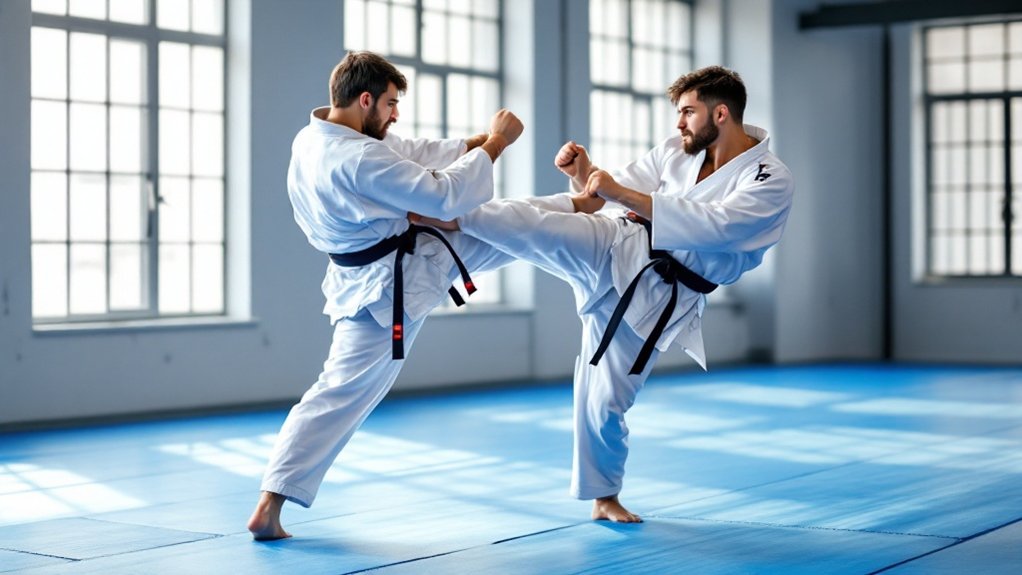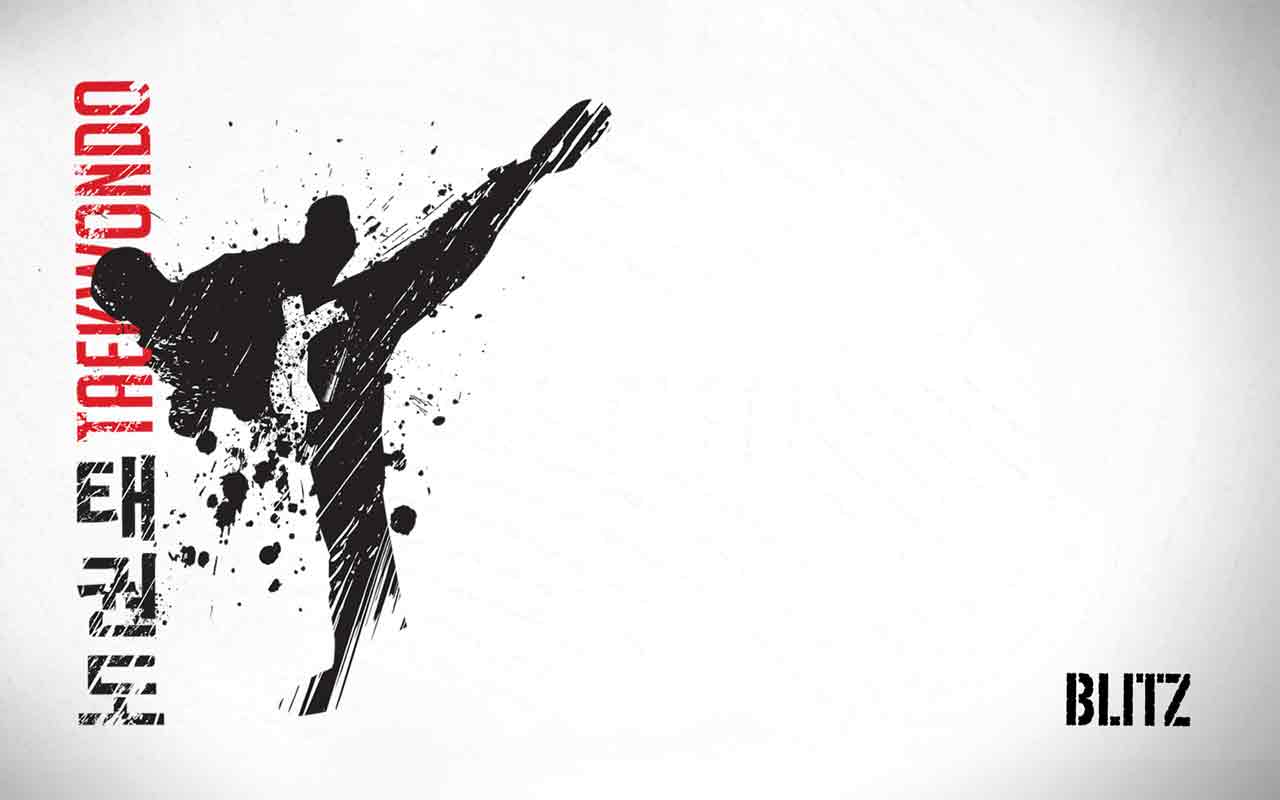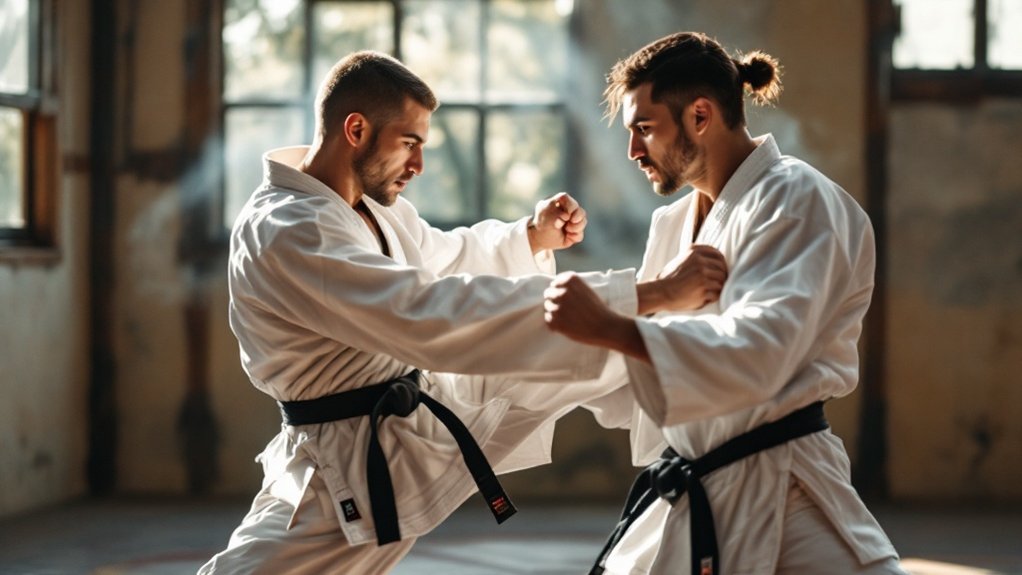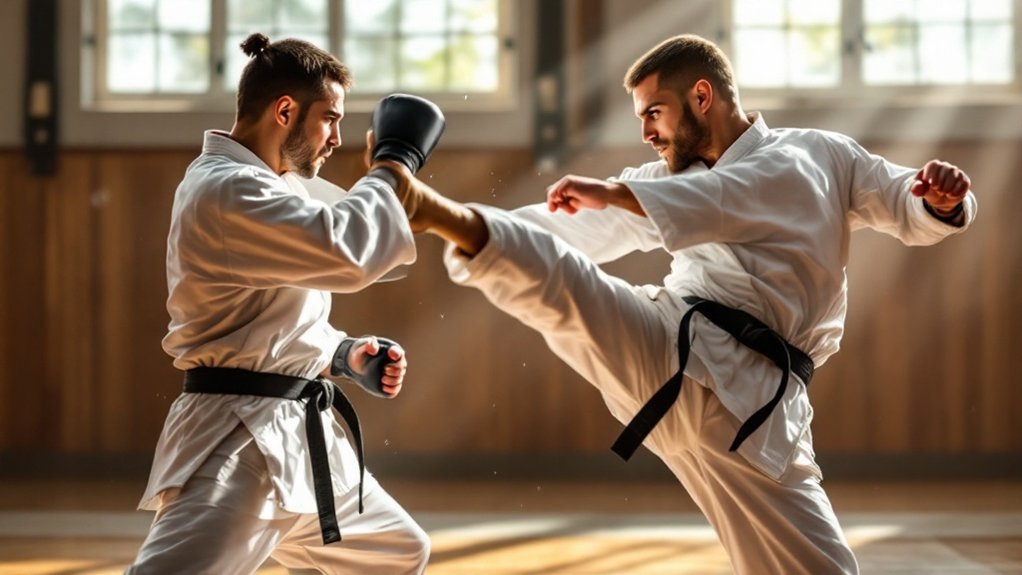Like a chess match played at lightning speed, sparring transforms your martial arts training from theory into visceral reality. You’ll never forget your first real sparring session – that mix of excitement and terror as you face a live opponent. I remember standing there, hands shaking, wondering if all those perfect techniques I’d practiced would actually work. There’s something profound that happens when you step onto those mats, knowing you’re about to discover what you’re truly capable of.
Physical and Mental Adaptations Through Combat Training

Combat training transforms both body and mind in ways I never imagined when I first stepped onto the mat. Through sparring, I’ve developed improved body awareness and augmented emotional control that carries over into daily life. A balanced stance and guard provide the foundation for both offensive and defensive capabilities.
Each session sharpens my reflexes while building mental toughness. Learning to execute hip rotations properly has dramatically increased my striking power. I’ve learned that true strength comes from mastering both physical techniques and psychological resilience. Regular sparring has taught me to adapt my style based on my body type strengths, allowing me to maximize my natural physical attributes in combat situations.

HOW ABOUT 4 WEEKS FOR $49?
Take advantage of this amazing special, before it’s too late!
Developing Real-World Fighting Instincts
Real fighting bears little resemblance to the choreographed moves you’ll see in movies. Through sparring, you’ll develop subconscious combat decision-making that taps into your natural physiological fight or flight responses. Mental preparation through visualization helps champions maintain focus during intense sparring sessions.
Sparring provides real-time feedback during training, enabling you to refine techniques and correct mistakes quickly. You’ll learn to read opponents instinctively, strike with precision, and adapt in real-time. As your body absorbs these lessons, you’ll find yourself flowing through combat situations with newfound confidence and control. Eight-limb techniques from Muay Thai demonstrate how sparring integrates multiple combat elements simultaneously.
The Technical Evolution of a Martial Artist

As technology reshapes martial arts training, I’ve witnessed firsthand how ancient wisdom meets modern innovation on the mats. Through wearable tech and AI feedback, you’ll discover unprecedented technique customization that enhances your training. Virtual reality simulations now allow practitioners to practice high-risk maneuvers safely while maintaining realism. Modern training methods incorporate Taegukgi forms to build a strong technical foundation through repetitive practice.
I’ve found that holistic skill integration, blending traditional methods with cross-disciplinary training, creates the most complete fighters. Your journey will evolve through a combination of time-tested wisdom and cutting-edge advances. Mental discipline techniques have become essential components of modern martial arts training, fostering both physical prowess and character development.

HOW ABOUT 4 WEEKS FOR $49?
Take advantage of this amazing special, before it’s too late!
Building Combat Intelligence and Strategic Thinking
The strategic depth of martial arts has always fascinated me beyond the physical movements.
Through sparring, you’ll develop emotional intelligence and combative intuition that transforms your training. When you face unpredictable opponents, you’re forced to think strategically while managing stress.
Both WTF and ITF styles emphasize different sparring approaches that build unique combat capabilities.
I’ve found that each sparring session sharpens your ability to read movements, adapt instantly, and maintain clarity under pressure. Mental discipline techniques help practitioners stay focused during intense exchanges. Regular sparring practice enhances your complex motor tasks and leads to improved executive function in the brain.
Safe Practice Methods for Long-Term Growth

While mastering martial arts requires dedication and intensity, I’ve learned through challenging experience that smart safety practices make the difference between thriving and burning out. You’ll need regular protective gear maintenance and clear partner assessment criteria. Proper breathing techniques are fundamental to maintaining control and focus during intense sparring sessions. Regular physical conditioning through strength and flexibility training helps build the foundation needed to prevent common injuries during sparring sessions. Wearing head protection gear during training is essential for preventing serious injuries and concussions that could derail your progress. I’ve seen too many talented students fade away because they skipped these basics. Trust me – your body will thank you for taking these precautions.
Frequently Asked Questions
How Long Should Beginners Wait Before Starting Their First Sparring Session?
You’ll want to train consistently for at least 1-2 months, focusing on proper technique development before sparring. Start with progressive sparring intensity once you’ve mastered basic movements and your instructor confirms you’re ready.
Can Sparring With Different Weight Classes Improve or Hinder Skill Development?
You’ll gain valuable skills sparring different weight classes, but carefully manage weight disparity considerations and skill level mismatch concerns. Focus on technique over power, and safeguard your partner maintains controlled, safe training practices.
What Percentage of Training Time Should Be Dedicated to Sparring?
You’ll want to dedicate just 2-7% of your training time to sparring, adjusting training intensity and frequency based on your skill level. That’s enough to sharpen your combat skills without risking burnout or injury.
How Does Cross-Training in Multiple Martial Arts Affect Sparring Performance?
You’ll augment your sparring performance through diverse training modalities, as techniques from different arts transfer seamlessly. You’ll develop unpredictable combinations, enhanced adaptability, and a stronger overall fight IQ, while reducing training plateaus.
Does Sparring Against Opposite-Gender Partners Require Different Training Approaches?
Yes, you’ll need to adapt your training to address physical differences in strength and technique, while ensuring mutual respect. Adjust your power output and explore various tactical approaches that work effectively for both partners.
Conclusion
You’ll find that consistent sparring transforms your martial arts journey from theory to reality. Just like how a pianist must practice with other musicians to truly master their craft, you need live combat training to develop authentic fighting instincts. Remember John, my first student who couldn’t land a single strike? After six months of dedicated sparring, he moved like water, anticipating attacks before they came. Your growth in martial arts depends on putting yourself to the test.

HOW ABOUT 4 WEEKS FOR $49?
Take advantage of this amazing special, before it’s too late!
